Anxiety disorders are a group of mental health conditions characterized by excessive fear and anxiety. They can interfere with daily activities and may cause physical symptoms. Common types include generalized anxiety disorder, panic disorder, social anxiety disorder, and specific phobias.

Anxiety Fact Sheet
Learn more about anxiety, its causes, symptoms, and treatment options. Download a free Anxiety Fact Sheet to educate your patients better.
Anxiety Fact Sheet Template
Commonly asked questions
The exact cause of anxiety disorders is complex and likely involves a combination of genetic, environmental, psychological, and developmental factors. Stressful life events or a family history of anxiety can increase the risk.
Diagnosis typically involves a comprehensive evaluation by a healthcare professional, including a physical examination, psychological assessment, and reviewing symptoms in accordance with criteria from the Diagnostic and Statistical Manual of Mental Disorders (DSM-5).
EHR and practice management software
Get started for free
*No credit card required
Free
$0/usd
Unlimited clients
Telehealth
1GB of storage
Client portal text
Automated billing and online payments











